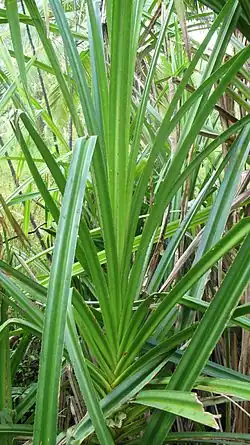Sararanga
| Sararanga | |
|---|---|

| |
| Leaves of Sararanga sinuosa | |
| Scientific classification | |
| Kingdom: | Plantae |
| Clade: | Tracheophytes |
| Clade: | Angiosperms |
| Clade: | Monocots |
| Order: | Pandanales |
| Family: | Pandanaceae |
| Genus: | Hemsl. |
| Species | |
|
See text | |
Sararanga is a genus of flowering plants in the family Pandanaceae, with two species that occur in the Philippines, the northern part of New Guinea, the Bismarck Archipelago and the Solomon Islands.[1] They are palm-like, dioecious trees. The genus name comes from the species of these plants named sararang in the Solomon Islands.
Species
- Sararanga philippinensis Merr., Publ. Bur. Sci. Gov. Lab. 29: 5 (1905).
- Sararanga sinuosa Hemsl., J. Linn. Soc., Bot. 30: 216 (1894).
References
- ^ "Sararanga Hemsl". Plants of the World Online. Royal Botanic Gardens, Kew. 2024. Retrieved 30 April 2024.